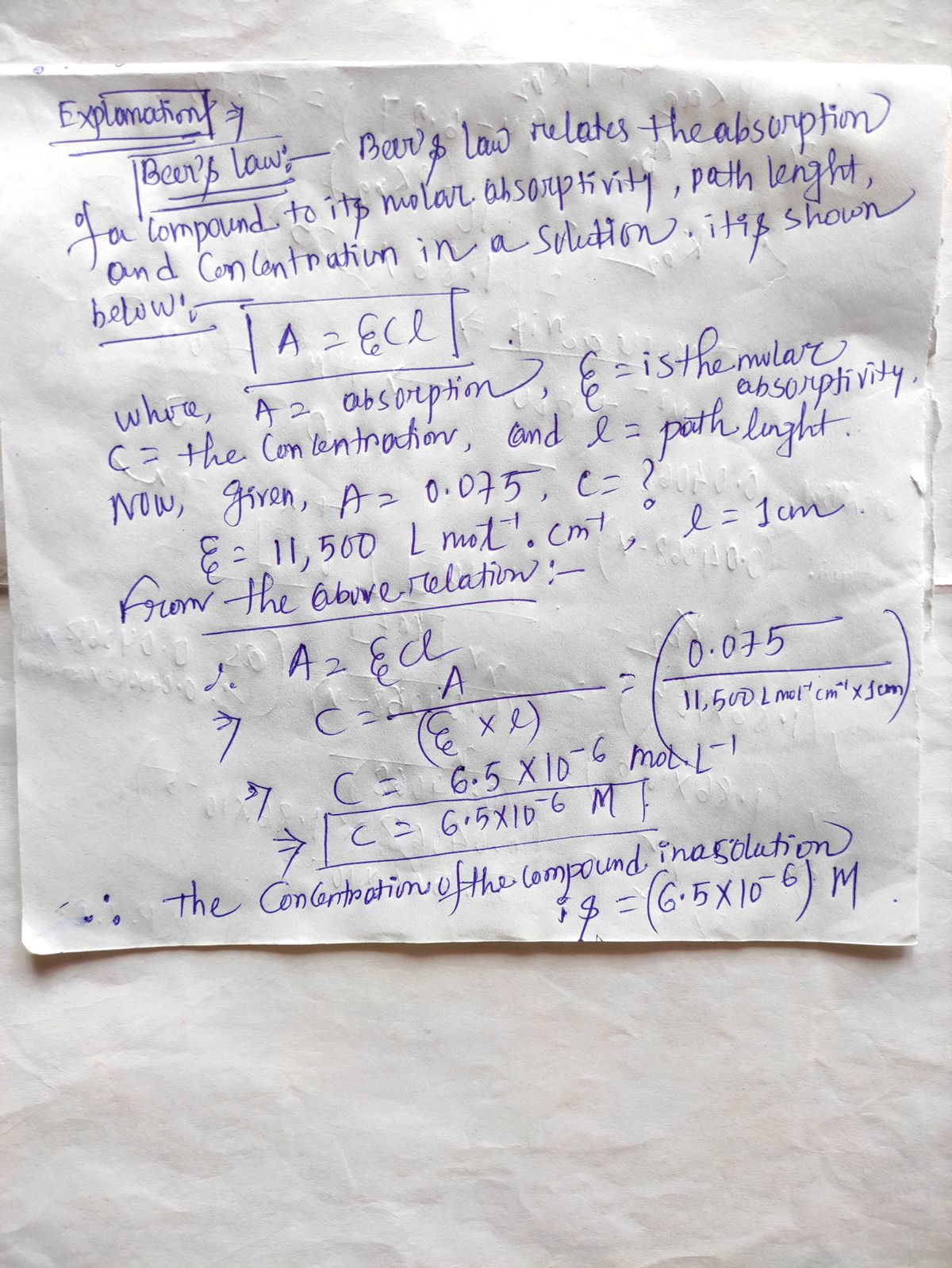A specific steroid has a Amax of 251 nm and a molar absorptivity e of 11, 500 L mol-¹ cm-¹. What is the concentration of the compound in a solution whose absorbance at 251 nm is A = 0.075 with a sample pathlength of 1.00 cm? concentration: M
A specific steroid has a Amax of 251 nm and a molar absorptivity e of 11, 500 L mol-¹ cm-¹. What is the concentration of the compound in a solution whose absorbance at 251 nm is A = 0.075 with a sample pathlength of 1.00 cm? concentration: M
Chemistry
10th Edition
ISBN:9781305957404
Author:Steven S. Zumdahl, Susan A. Zumdahl, Donald J. DeCoste
Publisher:Steven S. Zumdahl, Susan A. Zumdahl, Donald J. DeCoste
Chapter1: Chemical Foundations
Section: Chapter Questions
Problem 1RQ: Define and explain the differences between the following terms. a. law and theory b. theory and...
Related questions
Question
![A specific steroid has a λ<sub>max</sub> of 251 nm and a molar absorptivity ε of 11,500 L mol<sup>−1</sup> cm<sup>−1</sup>. What is the concentration of the compound in a solution whose absorbance at 251 nm is A = 0.075 with a sample pathlength of 1.00 cm?
**Concentration:** [Textbox] M
### Explanation:
This problem relates to the application of Beer-Lambert Law in determining the concentration of a compound in a solution. The Beer-Lambert Law is expressed as:
\[ A = \varepsilon \cdot c \cdot l \]
Where:
- \( A \) is the absorbance.
- \( \varepsilon \) is the molar absorptivity (in L mol<sup>−1</sup> cm<sup>−1</sup>).
- \( c \) is the concentration of the solution (in mol L<sup>−1</sup>).
- \( l \) is the path length of the sample cell (in cm).
In this scenario:
- The maximum wavelength \( λ<sub>max</sub> \) is 251 nm.
- The molar absorptivity \( \varepsilon \) is 11,500 L mol<sup>−1</sup> cm<sup>−1</sup>.
- The absorbance \( A \) is 0.075.
- The path length \( l \) is 1.00 cm.
To find the concentration \( c \), rearrange the equation:
\[ c = \frac{A}{\varepsilon \cdot l} \]
Substituting the known values will yield the concentration.](/v2/_next/image?url=https%3A%2F%2Fcontent.bartleby.com%2Fqna-images%2Fquestion%2F2f591c64-216a-4120-ac44-1b23dfa641af%2F57fa69ea-2a8c-4677-ab2d-fdabec2092c8%2F4pnfqzh_processed.jpeg&w=3840&q=75)
Transcribed Image Text:A specific steroid has a λ<sub>max</sub> of 251 nm and a molar absorptivity ε of 11,500 L mol<sup>−1</sup> cm<sup>−1</sup>. What is the concentration of the compound in a solution whose absorbance at 251 nm is A = 0.075 with a sample pathlength of 1.00 cm?
**Concentration:** [Textbox] M
### Explanation:
This problem relates to the application of Beer-Lambert Law in determining the concentration of a compound in a solution. The Beer-Lambert Law is expressed as:
\[ A = \varepsilon \cdot c \cdot l \]
Where:
- \( A \) is the absorbance.
- \( \varepsilon \) is the molar absorptivity (in L mol<sup>−1</sup> cm<sup>−1</sup>).
- \( c \) is the concentration of the solution (in mol L<sup>−1</sup>).
- \( l \) is the path length of the sample cell (in cm).
In this scenario:
- The maximum wavelength \( λ<sub>max</sub> \) is 251 nm.
- The molar absorptivity \( \varepsilon \) is 11,500 L mol<sup>−1</sup> cm<sup>−1</sup>.
- The absorbance \( A \) is 0.075.
- The path length \( l \) is 1.00 cm.
To find the concentration \( c \), rearrange the equation:
\[ c = \frac{A}{\varepsilon \cdot l} \]
Substituting the known values will yield the concentration.
Expert Solution
Step 1

Step by step
Solved in 2 steps with 2 images

Knowledge Booster
Learn more about
Need a deep-dive on the concept behind this application? Look no further. Learn more about this topic, chemistry and related others by exploring similar questions and additional content below.Recommended textbooks for you

Chemistry
Chemistry
ISBN:
9781305957404
Author:
Steven S. Zumdahl, Susan A. Zumdahl, Donald J. DeCoste
Publisher:
Cengage Learning

Chemistry
Chemistry
ISBN:
9781259911156
Author:
Raymond Chang Dr., Jason Overby Professor
Publisher:
McGraw-Hill Education

Principles of Instrumental Analysis
Chemistry
ISBN:
9781305577213
Author:
Douglas A. Skoog, F. James Holler, Stanley R. Crouch
Publisher:
Cengage Learning

Chemistry
Chemistry
ISBN:
9781305957404
Author:
Steven S. Zumdahl, Susan A. Zumdahl, Donald J. DeCoste
Publisher:
Cengage Learning

Chemistry
Chemistry
ISBN:
9781259911156
Author:
Raymond Chang Dr., Jason Overby Professor
Publisher:
McGraw-Hill Education

Principles of Instrumental Analysis
Chemistry
ISBN:
9781305577213
Author:
Douglas A. Skoog, F. James Holler, Stanley R. Crouch
Publisher:
Cengage Learning

Organic Chemistry
Chemistry
ISBN:
9780078021558
Author:
Janice Gorzynski Smith Dr.
Publisher:
McGraw-Hill Education

Chemistry: Principles and Reactions
Chemistry
ISBN:
9781305079373
Author:
William L. Masterton, Cecile N. Hurley
Publisher:
Cengage Learning

Elementary Principles of Chemical Processes, Bind…
Chemistry
ISBN:
9781118431221
Author:
Richard M. Felder, Ronald W. Rousseau, Lisa G. Bullard
Publisher:
WILEY